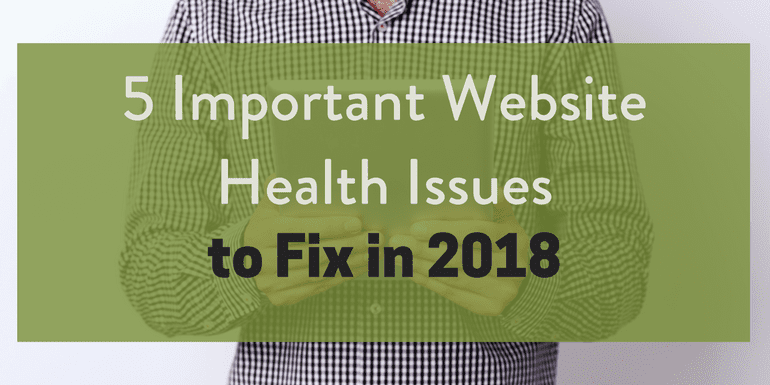Just as you might look for ways to improve your health and well-being at the New Year, looking over your website to identify areas of improvement is also a great idea. It’s so easy to let a website go unpolished throughout the year when you’re so busy with everything else!
Certain aspects of your website, though, could be costing you leads if they aren’t updated. So, take a couple moments to look over these website essentials for 2018.
5 important website health issues to fix in 2018
1. Site Speed
Did you know that site speed can affect your organic rankings, traffic and leads? Google first announced that it would use PageSpeed as a ranking factor back in 2010:
You may have heard that here at Google we’re obsessed with speed, in our products and on the web. As part of that effort, today we’re including a new signal in our search ranking algorithms: site speed. Site speed reflects how quickly a website responds to web requests.
Not only could the speed of your website be causing you to rank lower in search, but a slow website can even cause visitors to give up and bounce away from your site. In fact, Google’s latest research shows that the chance of a bounce increases 32% when the page load time goes from 1s to 3s. That’s a 2 second difference! If someone has to wait just 3 seconds instead of 1, their risk of bouncing away from your site instead of waiting increases by 32%. Web users today are demanding, and they’ll give up if your site doesn’t live up to their expectations.
Thankfully, Google provides a great resource for PageSpeed: PageSpeed Insights. Head over to their tool and input your website to see how fast it is. If it needs improvement, contact a web developer.
2. Updated Content
Outdated content, whether it’s on your main site pages or your blog, can not only make your website look outdated to anyone who visits, but it doesn’t do you any favors SEO-wise either. It’s important for your site to have fresh content, updated on a daily/weekly basis, to contend with your competitors and keep Google crawling your site. Search engines love fresh content – updated, new content shows that your website is up-to-date and relevant.
To make sure you’re taking advantage of Google’s love for fresh content, you should be looking at your main site pages often with a critical eye for where content could be expanded upon or improved, and have a strategy for posting new content as often as possible. This could mean having a blog, publishing whitepapers, or whatever would be valuable for your audience.
The best way to update your content is to use an editorial calendar and a content strategy.
3. Broken Links
Having broken links on your site could not only be potentially aggravating for a visitor, but is also a reason for Google to hold your site in lower regard. RavenTools says:
Search engines see links as a vote for a website’s quality. Links to your website and links within your website can affect where your website ranks in search results. Because of this, it’s best practice to either remove or update broken links.
Cleaning up broken links can add context to your website, improve user experience, and make content within your website easier for visitors and search engines to discover. On the other hand, websites with too many broken links can be a signal of low quality to search engines.
So, in a nutshell, it’s not great for your visitors or search engines to have broken links on your site. Luckily, broken links are a pretty easy fix. Google conveniently lets you know when it finds a broken link on your site – just set up Google Search Console. There are many broken link checking tools around the web, too.
4. Mobile-Friendliness
Google announced back in November of 2016 that they’d be eventually using primarily mobile sites to determine ranking signals. That means that Google will crawl your mobile site structure/content and use those results to determine where you rank both in mobile and desktop searches. It has taken a while, but as of December 2017, they were testing it for some sites. In 2018, it’s quite possible that the mobile-first index will be a reality.
There are a couple things you can do to prepare. First of all, run your site through Google’s Mobile-Friendly Test. If any improvements are recommended, take action sooner rather than later. Next, check your PageSpeed on mobile. If your site’s mobile speed could use improvements, make sure to follow the suggestions Google gives in the speed test results.
Beyond those two things, just make sure your site looks and functions nicely from a user standpoint, includes all your important content, and is optimized in terms of on-page content and meta data.
5. Search engine-friendly backlinks
Please note, this is a more advanced tactic. Please use caution and get help when you need it.
Having a professional take a look at your backlinks on a regular basis is incredibly important. If you’ve got several spammy sites with links to your site on them, your organic visibility could be affected. Tools such as Moz’s Open Site Explorer can show you which links to your site might be spammy, so that you can investigate. If you do find several spammy links, ask a professional to submit a disavowal to Google. A disavowal means Google will overlook those links for you, so that they no longer affect your organic rankings.
Need help with any of the above tactics to get your site working and ranking better in 2018? Don’t hesitate to chat with us!
